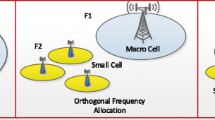Abstract
As the number of user devices growing rapidly for the current 4G communications, it is expected that the problem of energy consumption for future mobile broadband communications will be more and more seriously. Therefore, how to effectively save the energy and reduce the carbon emission are very important issues for the green communications. In this paper, an analytic and energy-efficient location determination method of the small cell access (SCA) is provided for the Heterogeneous Network. The proposed method can be applied to any kind of distribution of the users in the considered region. Combined with the Coordinated Multi-Point (CoMP) technique, the energy consumption can be further reduced. Computer simulation and outdoor field experiments are conducted to verify the performances. Results demonstrate the correctness of the derivatives and the proposed method outperforms than the compared literature methods. According to the simulation results, the proposed method with the CoMP technique can save about 70% energy for the conventional co-located antenna system architecture and 20% compared with the uniformly distributed arrangement SCA method.


















Similar content being viewed by others
References
Liu, W., et al. (2013). Massive MIMO or small cell network: Who is more energy efficient? In IEEE wireless communications and networking conference workshops (WCNCW), 2013.
Zhang, C., et al. (2010). Optimal locations of remote radio units in CoMP systems for energy efficiency. In IEEE vehicular technology conference fall (VTC 2010-Fall), 2010.
Shao, S., et al. (2013). Energy–efficient radio remote units placement for single–user uplink in C-RAN. Concurrency and Computation: Practice and Experience, 25(9), 1073–1080.
Park, E., & Lee, I. (2011). Antenna placement for downlink distributed antenna systems with selection transmission. In IEEE vehicular technology conference (VTC spring), 2011.
Dai, L. (2008). Distributed antenna system: Performance analysis in multi-user scenario. In 42nd Annual conference on information sciences and systems, IEEE, 2008.
Abd El-atty, S. M., & Gharsseldien, Z. M. (2017). Performance analysis of an advanced heterogeneous mobile network architecture with multiple small cell layers. Wireless Networks, 23(4), 1169–1190.
Ngo, H. Q., Larsson, E. G., & Marzetta, T. L. (2013). Energy and spectral efficiency of very large multiuser MIMO systems. IEEE Transactions on Communications, 61(4), 1436–1449.
Lin, P. C., Casanova, L. F. G., & Lin, Y. C. (2017). Analytical framework for power saving evaluation in two-tier heterogeneous mobile networks. Wireless Networks, 23(4), 985–999.
Wang, X., Zhu, P., & Chen, M. (2009). Antenna location design for generalized distributed antenna systems. IEEE Communications Letters, 13(5), 315–317.
GPP TR25.942 (V11.0.0). Technique Specification Group Radio Access Network, Radio Frequency (RF) system scenarios (Release 11), 2012.
Author information
Authors and Affiliations
Corresponding author
Rights and permissions
About this article
Cite this article
Li, CM., Liu, CY. & Tsai, CY. Analytic and Flexible Location Determination of the Small Cell for the Heterogeneous Network. Wireless Pers Commun 97, 733–748 (2017). https://doi.org/10.1007/s11277-017-4534-3
Published:
Issue Date:
DOI: https://doi.org/10.1007/s11277-017-4534-3




